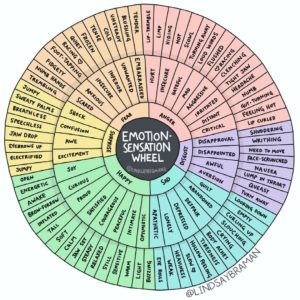The vital importance of recognizing and naming your emotions
Emotions are experienced throughout the body (nausea, blushing, sweaty palms, …) and the Lindsay Braman “Emotion-Sensation Wheel” is a great tool that supports the mind-body awareness and connection.
The outside ring of the wheel contains descriptions of the physical sensation and the two inner rings show the emotions that may be linked to it. As its creator says, this wheel is a conversation jumping-off point, not an authority, and the sensation might differ depending on the person. But all responses generate opportunities for making connections and prompt valuable conversations.

Photo via Instagram / @lindsaybraman
Alexithymia – as opposed to emotional literacy – is the difficulty identifying, describing, and expressing emotions. The term, coined by Peter Sifneos in 1972, comes from the roots of Greek words that literally means “lack of words for emotion”. At its most pronounced, this condition seems to affect 1 in 10 people, but many (if not most) humans have some familiarity with the experience of not being able to really recognize and express their feelings.
Why is it important to notice and name your emotions?
According to Bessel Van Der Kolk in his book “The body keeps the score”, people who experience psychological trauma or emotional overload without being able to connect and integrate their feelings are likely to resort to developing non-verbal compensatory strategies as coping mechanisms (binge eating, excessive drinking, workaholism, drug and sex addiction, etc.)
Developing a deeper understanding about what we feel is crucial to incorporate adequate coping skills, regulate our emotions cognitively, and effectively engage in interpersonal relationships. Emotional awareness allows us to better understand ourselves, communicate with others, and guide us to take certain actions.
How to start acknowledging your emotions?
Vipassana meditation (mindfully scanning the body sensations) is a great tool to check-in with ourselves and start assessing what our body might be telling us about our emotional state. That way we can learn to recognize a particular emotion by learning to recognize and name the associated body sensations, so we can slowly build neurological connections that will help support our emotional growth.
By engaging the conscious logical brain, the body, and the emotional-limbic system, we can process our feelings, integrate and effectively express them (through a number of ways, including communication, art, movement, and writing).
Emotional literacy allows us to create meaningful connections with ourselves and others.
